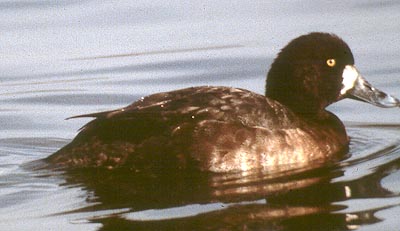

 |
Photos © Albert Ghiorso All rights reserved. |
 |
Perhaps last month's goldfinches were too easy. If anything, these scaup were too hard. I anticipate the brave participants on our message board will not be happy with my opinions this month. I believe the top birds are both Lesser Scaup and the bottom one is a Greater Scaup.
The top pair was found on a field trip I was leading in July 1980. At the time I identified them as Greater Scaup. Of particular interest was the fact that they were escorting two chicks. Greater Scaup has not nested in California before, but Lesser Scaup has; so I was eager to get the identification confirmed. I sent out copies of the photos to various experts, most of whom either favored Greater Scaup or were unwilling to commit.
At the time I was struck that the female had a dark eye. Female Scaup in winter normally show a yellow eye. Because of this, one consultant suggested it was actually a female Redhead. However, the face pattern and overall color is wrong for Redhead. I located an article published in "The Auk" on variation in eye color in Lesser Scaup. The paper even included a color plate showing the eyes of Lesser Scaup of various ages.
Trauger, David L. 1974. Eye Color of Female Lesser Scaup in Relation to Age. Auk 91(2):243-254.
It turns out that young females have dark eyes and they become yellow as they get older. Our female is probably in its second calendar year. Trauger had done his dissertation on the ecology of breeding Lesser Scaup in the Yukon:
Trauger, D. L. 1971. Population ecology of Lesser Scaup (Aythya affinis) in subarctic taiga. Ph.D. dissertation, Ames, Iowa State University.
Seeking someone experienced with breeding scaup, I sent the photos to Trauger who wrote back stating that they were clearly typical Lesser Scaup showing all characters of that species. He did not provide more specific details, but the opinion of someone who has worked extensively with breeding scaup and has specialized on them cannot be dismissed. After much thought and further field experience, I eventually came to agree with Trauger.
The head shapes that help separate the two scaup in winter are quite different in the summer. The peaked appearance of the Lesser Scaup's head is composed mostly of bushy feathers standing up on the crown. But in summer, the feathers are much shorter which results in the eye being much closer to the crown. I concluded that we should not to place too much emphasis on the shape of the crown when dealing with breeding scaup.
I found that a more reliable difference was the ratio of the width of the head to the length of the body. Lesser Scaups have much narrower heads than Greaters and that difference is based on the actual skull, not the feathers. The width of the head on Lesser is about 1/4 of the body length while that of Greater is about 1/3 of body length. This should work with photos in good profile. Using this formula, the upper birds are Lesser Scaup and the lower one is a Greater.
Recently I presented a program on female ducks to the Central Valley Birding Symposium. I used the lower picture as an example of a Greater Scaup. After the talk, one participant asked for the reasons why it was a Greater and suggested it might be a Lesser. There was spirited debate with some participants fairly sure that it was a Lesser. This bird was photographed in winter and it's interesting to note the way the head feather lie down on the crown instead of sticking up as they usually do on Lesser. I think this arrangements contributes to the overall more rounded crown of Greater Scaup in winter. Nevertheless, there is still still a lot of fluff in the crown as evidenced by the relative location of the eye, compared to the upper birds.
I think the bill nail is ambiguous in both pictures. To use this character, one has to have the bird facing directly at you. There is more difference in distribution of black on the tip of the bill than there is in the actual nail. On Lesser Scaup the nail spreads well beyond the narrow black marking while on Greater the whole nail is colored black. So the difference is not really the size of the nail, but the size and shape of the black spot. This difference is much easier to see on males because the black mark contrasts more with the blue-gray bill than on females which have darker bills. In any event, that character cannot be easily assessed from these photos although I think the bottom photo supports Greater.
The relative bill size may be helpful, but the main difference is that the bill of Greater Scaup is broader at the tip than Lesser. Again a facing view is helpful in assessing this difference. The relatively large bills of the upper pair is an artifact of the smaller looking heads.
Lastly, female scaup of both species usually show a white facial mark behind the cheek. I believe that character is useless in separating the two species in Summer.